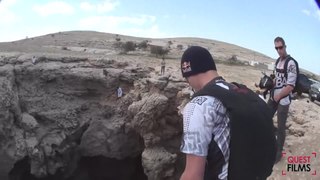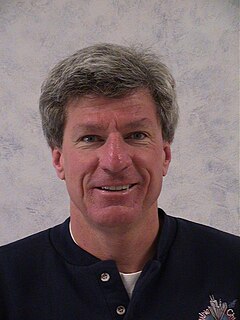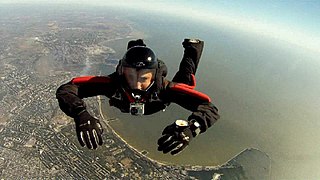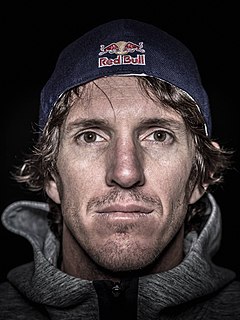
BASE jumping is the recreational sport of jumping from fixed objects, using a parachute to descend safely to the ground. "BASE" is an acronym that stands for four categories of fixed objects from which one can jump: buildings, antenna, spans (bridges), and earth (cliffs). Participants exit from a fixed object such as a cliff, and after an optional freefall delay, deploy a parachute to slow their descent and land. A popular form of BASE jumping is wingsuit BASE jumping.

Freeflying is a skydiving discipline which began in the late 1980s, involving freefalling in various vertical orientations, as opposed to the traditional "belly-to-earth" orientation. The discipline is known to have originated when Olav Zipser began experimenting with non-traditional forms of bodyflight. Zipser founded the FreeFly Clowns as a two-person competitive team with Mike Vail in 1992, and was joined by Omar Alhegelan, Charles Bryan, and Stefania Martinengo in 1994. The FreeFly Clowns are also credited with opening the first school to teach freeflying, The First School of Modern SkyFlying.

Sky surfing is a type of skydiving and extreme sport in which the skydiver wears a custom skysurf board attached to the feet and performs surfing-style aerobatics during freefall.

Wingsuit flying is the sport of skydiving using a webbing-sleeved jumpsuit called a wingsuit to add wetted area to the diver's body and generate increased lift, which allows extended air time by gliding flight rather than just free falling. The modern wingsuit, first developed in the late 1990s, uses a pair of fabric membranes stretched flat between the arms and flanks/thighs to imitate an airfoil, and often also between the legs to function as a tail and allow some aerial steering.

Tandem skydiving or tandem parachuting refers to a type of skydiving where a student skydiver is connected to an instructor via a harness. The instructor guides the student through the whole jump from exit through freefall, piloting the canopy, and landing. The student needs only minimal instruction before making a tandem jump with the instructor. In the United States most skydiving centers and clubs require that you be 18 years or older to skydive whereas in other countries the minimum age can be lower or higher. This is one of three commonly used training methods for beginning skydivers; the others being Static line, Instructor-assisted deployment (IAD), and Accelerated freefall (AFF) (k).

Accelerated freefall (AFF) is a method of skydiving training. This method of skydiving training is called "accelerated" because the progression is the fastest way to experience solo freefall, normally from 10,000 to 15,000 feet above ground level (AGL). In static line progression, more jumps are required to experience freefall, but the jumps are less expensive for the student as one instructor can dispatch multiple students per load and students are initially dispatched from lower altitudes. Under accelerated freefall, one or sometimes two instructors are dedicated just to one student.

Felix Baumgartner is an Austrian skydiver, daredevil and BASE jumper. He is best known for jumping to Earth from a helium balloon from the stratosphere on 14 October 2012 and landing in New Mexico, United States as part of the Red Bull Stratos project. Doing so, he set world records for skydiving an estimated 39 km (24 mi), reaching an estimated top speed of 1,357.64 km/h (843.6 mph), or Mach 1.25. He became the first person to break the sound barrier relative to the surface without vehicular power on his descent. He broke skydiving records for exit altitude, vertical freefall distance without a drogue parachute, and vertical speed without a drogue. Though he still holds the two latter records, the first was broken two years later, when on 24 October 2014, Alan Eustace jumped from 135,890 feet—or, 41.42 km (25.74 mi) with a drogue.

Roger Warren Nelson was a skydiver and founder of Skydive Chicago, one of the largest skydiving centers in the United States.
In the United States, skydiving is a self-regulated sport, which means skydivers, in the US, voluntarily follow a set of basic safety requirements established by the U.S. Parachute Association. Federal requirements can be found in the Federal Aviation Regulations. Most of the regulations concern the aircraft, pilot and rules of flight. However, 14 CFR Part 105, "Parachute Operations" regulates when and where jumps may be made and designates the requirements for parachute equipment and packing. For example, 14 CFR Part 105 requires the person packing either the main chute or the reserve parachute to be a certificated rigger, which means he or she has taken an FAA-approved training course and has passed rigorous FAA testing.

Skydive Hibaldstow is a BS affiliated parachuting centre and skydiving drop zone at Hibaldstow, in North Lincolnshire, England.

The Parachute Association of South Africa (PASA) manages the sports of parachuting and skydiving in South Africa on behalf of the South African Civil Aviation Authority.

Banzai skydiving is a rumored form of skydiving in which the skydiver throws their parachute out the airplane door, waits, and then jumps after it. To be successful, the skydiver must catch the parachute, secure it, and glide to the projected landing zone. There is no known, credible evidence that a banzai skydive has ever really occurred according to its definition.

Parachuting, including also skydiving, is a method of transiting from a high point in the atmosphere to the surface of Earth with the aid of gravity, involving the control of speed during the descent using a parachute or parachutes.
Perris Valley Airport is a privately owned and operated airport open to public use and located one mile (1.6 km) southeast of Perris, serving Riverside County, California, United States. It has one runway and is used for general aviation and extensive skydiving. The airport operates from dawn to dusk daily year-round.
Red Bull Stratos was a high altitude skydiving project involving Austrian skydiver Felix Baumgartner. On 14 October 2012, Baumgartner flew approximately 39 kilometres (24 mi) into the stratosphere over New Mexico, United States, in a helium balloon before free falling in a pressure suit and then parachuting to Earth. The total jump, from leaving the capsule to landing on the ground, lasted approximately ten minutes. While the free fall was initially expected to last between five and six minutes, Baumgartner deployed his parachute after 4 minutes and 19 seconds.

Roberta Mancino is an Italian skydiver, BASE jumper, wingsuit flyer and international model. She has participated in more than 12,500 skydives and won several awards and world records. She has gone on four skydives while completely naked, and on five occasions her parachute did not open in mid-jump. In 2010, Mancino was named the World's Sexiest Female Athlete by the magazine Men's Fitness.

Olav Zipser is a multiple-time world champion, Sports Emmy Award-winning, pioneering skydiver.

Skydive Empuriabrava is the brand that has been commercially operating Empuriabrava Aerodrome since 1985. Since it began operating its main activity has been skydiving although it also offers photo flights, aerial and tourist advertising, and runs a school of aviation for private pilots.
Marc Hauser is a professional Swiss skydiver, artist and entrepreneur. He is the founder of speed tracking and holds the world record for the fastest horizontal free fall. Hauser is also the founder of Erfolgswelle AG, a communications agency.

Jeff "Jeffro" Provenzano is an American professional skydiver, wingsuit flyer, BASE jumper, HALO jumper and stuntman. He is a member of the Red Bull Air Force, and is considered to be a pioneer of the skydiving discipline of swooping.















